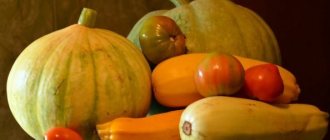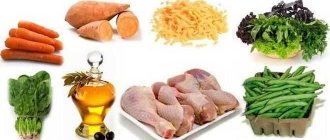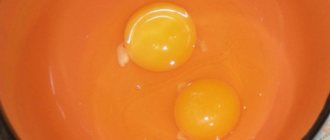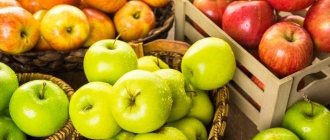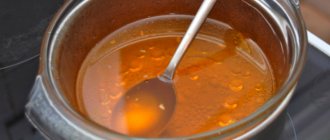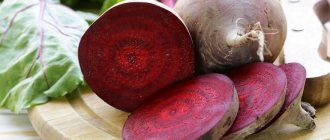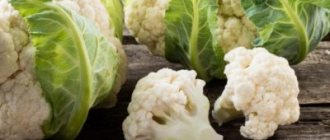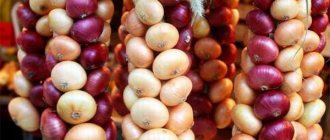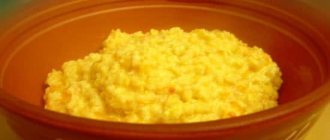Patients diagnosed with pancreatitis are forced to constantly follow a special diet that excludes any harmful foods. The diet becomes especially limited during an exacerbation of the disease, when any error in the diet causes severe abdominal pain, nausea, vomiting and other symptoms may appear that significantly worsen the patient’s well-being and quality of life. Pumpkin for pancreatitis is introduced into the patient’s menu quite quickly after the exacerbation subsides, since it is a very useful product that has a beneficial effect on the condition of the pancreas and the entire digestive tract.
Useful properties of the vegetable
The composition of pumpkin is very rich and varied. It includes a large amount of vitamins and microelements, as well as pectins, proteins, carbohydrates, and coarse fiber. Moreover, the calorie content of dishes made from it is very low.
Due to its composition, when consumed regularly, pumpkin brings many benefits to the body:
- It has a positive effect on the functioning of the nervous system due to the presence of B vitamins.
- Improves the structure of the skin and mucous membranes, accelerates tissue regeneration, and also has a beneficial effect on the condition of the eyes, thanks to a large amount of vitamins A, E and C.
- Provides rejuvenation of the body, good prevention of malignant neoplasms, thanks to the antioxidant effect of vitamins.
- Normalizes the evacuation function of the intestines, eliminates constipation as a result of the mild effect of vegetable pumpkin fiber on the gastrointestinal tract.
- Eliminates increased stomach acidity, since pumpkin pulp has an alkaline environment.
- It has a beneficial effect on the hematopoietic system and organs of the cardiovascular system due to the presence of microelements necessary for them (calcium, iron, magnesium, potassium and others).
- Removes excess fluid, eliminates swelling.
- Promotes weight loss in obesity due to the fact that pumpkin dishes are low in calories, but at the same time they are good at eliminating the feeling of hunger. They can be included in almost any diet.
Useful qualities of pumpkin and its composition
Pumpkin is a large berry with a delicate structure. The composition includes pectin, carotene, copper, potassium, fiber, magnesium and B vitamins. Thanks to its rich composition, the vegetable exhibits a number of medicinal properties:
- Removes cholesterol, bile and toxins harmful to the body.
- Dilates blood vessels.
- Reduces the level of acidity in the stomach, counteracts inflammatory processes.
- Improves hematopoiesis, accelerates wound healing.
- Improves metabolism.
- Stabilizes processes in the nervous system, normalizes sleep and memory.
Pumpkin contains a minimum of calories, absorption in the body is easy. Carotene, which is part of the berry, improves vision and helps prevent the development of cancer. In addition to B vitamins, pumpkin contains vitamins A, C, and E. The vegetable is good for the body and improves heart function.
Along with the benefits of the product, pumpkin produces an alkalizing effect. Melon culture is not recommended for consumption by people suffering from hyposecretory gastritis. Due to the presence of sugar, the vegetable should not be consumed by diabetics.
Contraindications for eating pumpkin
There are few conditions under which you cannot eat pumpkin, but they are worth remembering:
- Diabetes mellitus: the berry contains quite a lot of sugars, the processing of which requires insulin. In diabetes, the pancreas does not produce enough of this hormone, so sugar-containing foods must be limited.
- Hypoacid gastritis: In this form of stomach disease, not enough hydrochloric acid is produced, which leads to problems in digesting food. Pumpkin further reduces the amount of stomach acid, thereby aggravating the course of the disease.
- Individual intolerance, allergy to carotene or to a special protein f225 found in the vegetable.
What should you not eat if you have pancreatitis?
Pancreatitis is a disease in which you have to give up many pleasures. So, in addition to alcohol, soda, Coca-Cola, and coffee are eliminated from life. And from food - any fast food, fats, lard and canned food.
In Acute
The acute stage of pancreatic inflammation requires careful selection of foods. Avoid hot spices and those vegetables or fruits that contain a lot of fiber and acids:
- cabbage;
- grape;
- oranges and lemons, etc.
When an attack occurs, the first thing that is prescribed is hunger, for absolute rest of the digestive system. Then they begin to introduce liquid pureed food.
Diet No. 5 includes many delicious dishes. There are a lot of permitted products, but it is important to follow the method of preparation. All cereals, vegetables and fruits are boiled and thoroughly ground.
For chronic
Chronic pancreatitis also forces you to follow a strict diet. The products, in fact, remain the same as for acute inflammation of the pancreas. But the way they are processed is less gentle. For example, vegetables can be eaten in slices, without mashing them. You can eat pieces of bread, but you cannot eat hot, fresh flour products with a crust.
Foods that are fried or smoked are still prohibited. You should not eat canned or pickled vegetables or fruits.
All types of fatty meat, fish and dairy products are prohibited.
For any type of pancreatitis, cabbage, radishes, citrus fruits, sorrel and other foods with vegetable acid remain undesirable.
Pumpkin at the stage of acute pancreatitis
During an exacerbation of pancreatic diseases, during the first few days, and sometimes up to a week, almost everything is excluded from the diet. The patient must fast to exclude any, even the most minimal, effect on the affected organ.
After the period of therapeutic fasting, mucous soups, porridges, and jelly are gradually introduced. Then you can start eating pumpkin.
Basic rules for eating dishes with pumpkin during the acute phase of pancreatitis:
- The vegetable is taken only thermally processed (boiled, stewed, baked in the oven, steamed), because the fiber of fresh pumpkin, despite its softness, provokes increased peristalsis of the intestines and gall bladder. And this will adversely affect the pancreas and its ducts, which must remain at rest until the tissues are completely healed.
- In dishes, this product should only be crushed for faster and better digestion.
- During this period, foods high in fat (milk, butter, sour cream, cream), seasonings, salt, and sugar should not be added to pumpkin dishes.
- The serving size should be small. For the first time, you can give 100 g of pumpkin dishes, for example, puree. With good tolerance and no patient complaints of pain, nausea, diarrhea, the amount of vegetables in the entire daily diet can be gradually increased to 300 g.
Pumpkin seeds
The seeds of the vegetable are useful, but patients with pancreatitis should eat them with great caution. They contain the following:
During a therapeutic diet, the amount of fat and fiber is reduced, because they are difficult to process and are an extra burden on the pancreas. It is not recommended to eat raw pumpkin seeds. They can be dried a little in the oven. They are allowed to be eaten only after 6-8 months. stable remission and following a diet. It’s worth starting with a small amount – no more than 10 pieces. in a day. Then the daily norm reaches 30-40 g. The seeds are added to salads or other dishes.
Dietary pumpkin dishes
You can prepare a large number of healthy and tasty dishes from pumpkin. It is added to soups, porridges with cereals, vegetable purees, desserts (casseroles, puddings).
Dietary cream soup
This dish can be eaten at any stage of the disease. Prepare cream soup according to the following recipe:
- Peel the vegetable and remove seeds, then cut 300 g of pulp into cubes.
- Place the pumpkin pieces in a saucepan, add half a liter of water, put on low heat, bring the water to a boil, and simmer for 10 minutes.
- Beat the hot soup with a mixer or blender until you obtain a puree-like homogeneous mass.
- Add a little more water and cook for 10 minutes.
During remission, instead of water, you can prepare this dietary soup with milk, and after cooking, add cream or a little butter to the finished dish. This cream soup is eaten warm.
Pumpkin porridge
Usually, to prepare porridge, pumpkin is boiled with wheat or rice cereal according to a simple recipe:
- Pour half a glass of cereal with water and cook until tender.
- Add 200 g of chopped pumpkin, a little milk, salt to the boiled cereal and cook for another 10 minutes.
- Place a tablespoon of butter into the prepared hot porridge.
You need to eat porridge warm, since hot dishes are contraindicated for pancreatitis due to the negative activating effect on the mucous membranes of the digestive tract. This dish is allowed to be eaten during the remission of pancreatitis.
Carrot-pumpkin puree
Pureed pumpkin dishes are especially useful for the pancreas and the gastrointestinal tract in general, as they are easily digested and absorbed even in conditions of impaired digestion. Prepare puree according to a simple recipe:
- You need to peel 300 g pumpkin and 100 g carrots, cut into small pieces.
- Place vegetables in a pan of boiling water.
- Bring to a boil again, then reduce the heat to low and simmer the ingredients until fully cooked.
- Drain off excess water and puree the pumpkin and carrots in a blender to a soft puree.
It is not advisable to add salt to the dish. Instead of boiling vegetables, you can bake or steam them using a slow cooker, and then use a blender. Vegetable puree can be eaten even during an exacerbation after acute pain has subsided, nausea, vomiting, and diarrhea have been eliminated.
Healthy pumpkin juice recipe
Pumpkin juice for protracted pancreatitis in remission can be taken in various forms and combinations. At the same time, the patient receives not only a therapeutic effect, but also pleasure from the taste of the product, because the disease makes it impossible to consume most food excesses, for example, sweets.
The most delicious drink is obtained from young fruits, weighing up to five to seven kilograms with bright orange pulp. One easy way to get a healthy drink is to cut the pulp into pieces and use a juicer to make juice. For cooking, it is allowed to use both fresh and frozen pulp.
Can be mixed in one to one proportions with apple, carrot, cranberry, orange or lemon juice. In any combination, the taste of the drink is simply excellent.
You can stock up on this miraculous drink for the winter using this recipe:
- squeeze juice from pumpkin and apples in proportions 1:1;
- add the zest of one lemon;
- add sugar at the rate of 250 grams per two liters of juice;
- put the mixture on the fire, bring it to 90 degrees, simmer for five minutes, then keep it on the switched off stove for a while and you can pour it into jars and roll up if desired.
The recommended dosage is 120 ml once a day before meals in the morning. The maximum daily dose is individually from 250 to 500 ml.
Pumpkin juice
This is a very tasty, aromatic drink. Pumpkin juice can be added to the diet only at the stage of stable remission, when the patient does not show any complaints for about 2-3 months.
First, it is recommended to dilute the juice from raw pumpkin a little with water, since the concentrated drink can be harmful: provoke increased intestinal motility, exacerbation of pancreatitis, cholecystitis, gastritis and other gastrointestinal pathologies due to the presence of fiber in the pulp of the juice. For the first time, you are allowed to drink no more than 50 ml of juice, then you should monitor your condition. If the symptoms of dyspeptic syndrome do not develop for about a day, then it is gradually allowed to increase the daily volume of the drink to 300 ml.
For variety, pumpkin juice is sometimes mixed with carrot or apple juice. These products contain enough sugar, so there is no need to add any additional sugar to the drink.
What is the best way to eat pumpkin?
Solid substances negatively affect the condition of the pancreas during inflammation. It is important that the pumpkin is not served raw, but boiled or grated. The best option would be to consume it in the form of puree, pudding, cream soup or porridge. They eat up to 300 grams of berries per day. It is allowed to stew, make casseroles from the pulp, and can be consumed raw at least three months after the acute phase of the disease.
Pumpkin dishes are introduced into the diet in accordance with the patient’s well-being. You will have to prepare permitted dishes. In the acute phase of the disease, there is not much choice in the variety of cooking methods. Gradually, other permitted products will be introduced, and new recipes will appear.
Pumpkin porridge
To prepare the porridge, you will need a handful of rice. Peel the berry pulp and cut into cubes. Rinse the rice and add it to the pan with water and pumpkin twenty minutes after the start of cooking.
